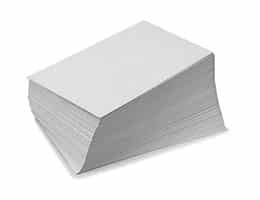 The etymology of grammage takes us to the French word grammage . The term refers to the weight of the paper per square meter , expressed in grams .
The etymology of grammage takes us to the French word grammage . The term refers to the weight of the paper per square meter , expressed in grams .
Paper is understood to be the thin sheet that is produced with vegetable fiber pulp. The papers can be used for writing, drawing, printing or wrapping, to name a few possibilities.
Square meter , meanwhile, is a unit of area equivalent to the surface of a square whose sides measure one meter each. Gram , for its part, is a unit of mass that is equivalent to 0.001 kilograms.
With these ideas clear, we can understand what grammage is, a concept that is also known as base weight . If we have a surface area of one square meter of paper, the grammage will be its weight in grams. This is, in short, a characteristic of the paper.
Weight is often confused with thickness (which is the distance between the two sides of a sheet). Both properties are usually linked since, generally, the grammage increases as the thickness increases. However, it must be taken into account that two papers with identical weight can have different thicknesses and vice versa.
Newspaper or newsprint usually has a weight of about 42 g/m² . This means that, if we take a sheet of newspaper with a surface area of one square meter (a square with four sides of one meter), its weight will be 42 grams.
The difference in weight between papers of different types is the reason why this concept must exist, since the paper industry must invest money in the manufacture and distribution of reams taking into account the number of sheets that can be produced and transported by time, one of the factors that influence the decision of the sale price .
Let's look at some types of paper with different weights: coated paper , also known as couché , and characterized by its satin texture , has a variable weight, with a range that starts at 60 grams and ends at 350 grams per square meter; offset paper has the same weight, although it is very porous and especially absorbent for ink; Creative paper is very rigid, it is used in high-resolution prints, and its weight ranges from 100 to 300 grams.
 To calculate the weight, you first need to weigh the paper on a scale . Then a simple rule of three can be used to determine the grammage. Let's look at the example of a sheet of paper measuring 50 square centimeters (c²) with a weight of 30 grams :
To calculate the weight, you first need to weigh the paper on a scale . Then a simple rule of three can be used to determine the grammage. Let's look at the example of a sheet of paper measuring 50 square centimeters (c²) with a weight of 30 grams :
50 square centimeters = 0.5 square meters
0.5 square meters = 30 grams
1 square meter = x grams
(1 square meter x 30 grams) / 0.5 square meters = 60 g/m²
The weight of the sheet in question, therefore, is 60 g/m² .
In this framework, it is important to clarify the way in which certain countries calculate and express the weight of materials related to this concept, which in addition to paper include fabric , for example. As indicated in the previous paragraphs, weight refers to the value in grams per square meter of a given material. However, it is also possible to measure the mass based on the number of leaves, to give rise to the aforementioned base weight .
Basis weight is the convention used in North America and other countries, where it is expressed in pounds per ream of 500 or 1,000 sheets that have not yet been cut into a specific format. In Japan, on the other hand, it is indicated as the weight in kilograms of thousand-leaf reams. There are also places in which both concepts, grammage and base weight, are used together.
